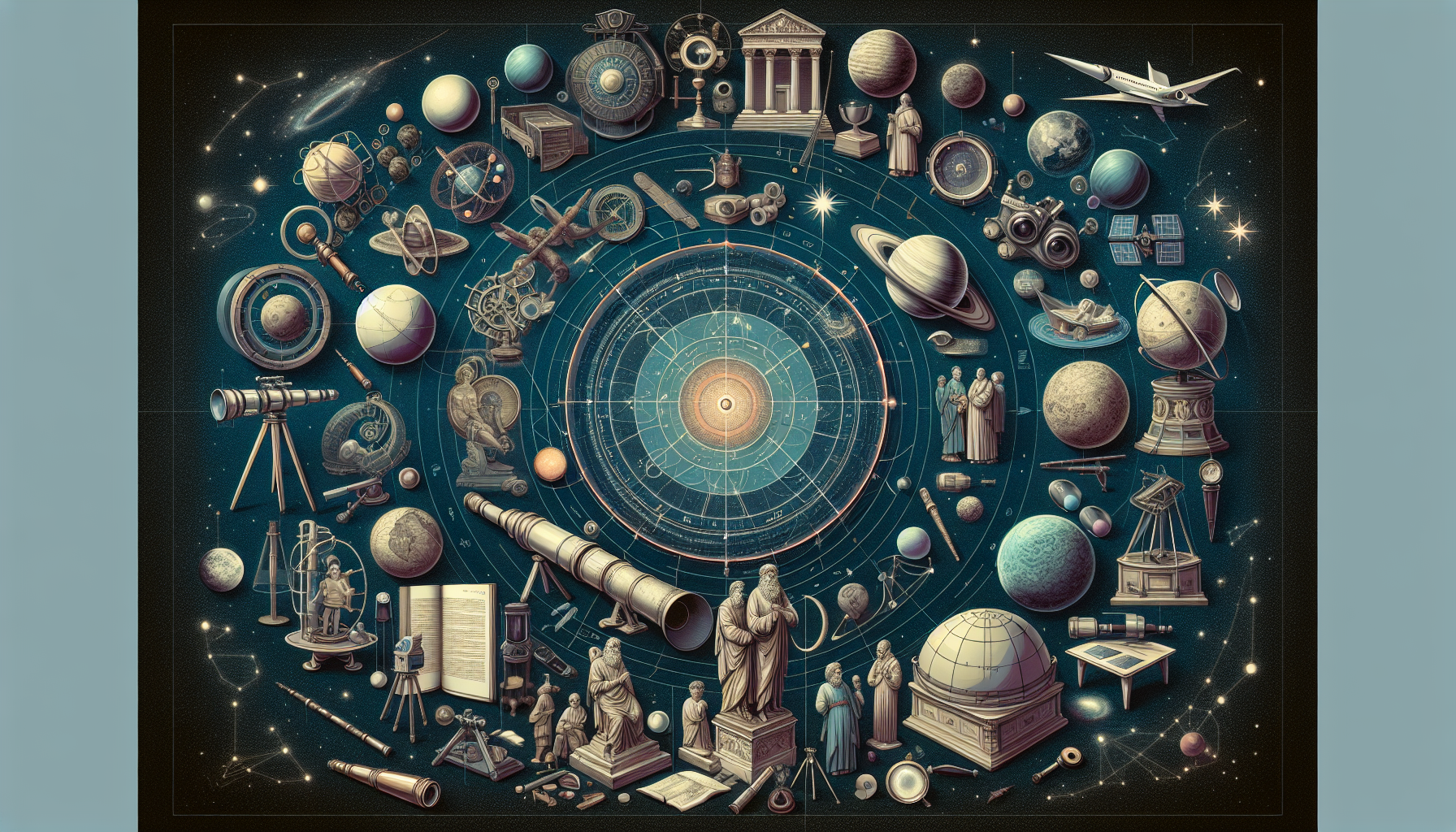Have you ever looked up at the night sky and wondered about the twinkling stars and mysterious celestial bodies? If so, you’re not alone. In the captivating article “Understanding Celestial Observation,” we’ll explore the enchanting world of star-gazing and delve into the fascinating realm of celestial observation. Whether you’re a novice or an experienced astronomer, this article will provide you with insights into the wonders of the universe and help unlock the secrets hidden amongst the stars. So, grab a comfy spot, gaze upwards, and let’s embark on a journey of celestial discovery!

Table of Contents
What is Understanding Celestial Observation?
Celestial observation refers to the practice of studying and observing celestial objects such as stars, planets, moons, comets, and asteroids. It involves gathering knowledge about these objects, their motions, and their interactions with each other and with the universe as a whole. Celestial observation has been a fundamental part of human civilization for thousands of years, contributing to our understanding of the universe and shaping various aspects of human life.
Historical Background
Ancient Civilizations
Celestial observation can be traced back to ancient civilizations, such as the Egyptians, Mesopotamians, and Chinese, who were some of the first to document and study the movement of celestial objects. They observed the regular patterns of stars and used them for navigation, timekeeping, and religious purposes.
Greek Contributions
The ancient Greeks made significant contributions to celestial observation. Philosophers like Aristotle and astronomers like Hipparchus and Ptolemy studied the movements of the stars and planets, proposing models that attempted to explain their motions. Their work laid the foundation for future advancements in this field.
Advancements in the Islamic Era
During the Islamic Golden Age, scholars such as Al-Battani, Al-Farghani, and Al-Zarqali made important contributions to celestial observation. They refined and improved the Greek models of celestial motion, developed new instruments and techniques, and greatly expanded our understanding of astronomy.
Renaissance and Scientific Revolution
The Renaissance and Scientific Revolution in Europe saw a resurgence of interest in celestial observation. Astronomers like Nicolaus Copernicus, Johannes Kepler, and Galileo Galilei challenged the prevailing geocentric model and proposed the heliocentric model, which placed the Sun at the center of the solar system. These revolutionary ideas reshaped our understanding of the cosmos and paved the way for further advancements in astronomy.
Celestial Objects
Stars
Stars are massive celestial objects made up of hot, glowing gases that emit light and heat. They are the building blocks of galaxies, including our own Milky Way. By observing stars, astronomers can gather information about their composition, temperature, size, and distance from Earth. The study of stars has allowed us to understand their life cycles, from their birth in nebulae to their eventual death as supernovae or white dwarfs.
Planets
Planets are celestial bodies that orbit around a star and do not produce their own light. Our solar system has eight known planets, including Earth. Celestial observation allows us to study the characteristics of planets, such as their size, composition, atmosphere, and geological features. By observing planets in other star systems, known as exoplanets, astronomers can gain insights into the diversity and potential habitability of other worlds.
Moons
Moons are natural satellites that orbit around planets. They come in various sizes and have unique features. Celestial observation enables us to study the movement, composition, and geological activity of moons. The study of moons within our solar system, such as Jupiter’s moon Europa or Saturn’s moon Titan, has yielded valuable information about the possibility of life beyond Earth.
Comets
Comets are icy bodies that orbit the Sun in highly elliptical paths. When a comet approaches the Sun, the heat causes the ice to vaporize, creating a glowing coma and a tail of gas and dust. By observing comets, astronomers can learn about the composition of these icy bodies, their origins in the outer regions of the solar system, and their role in the formation of planets.
Asteroids
Asteroids are rocky objects that orbit the Sun, primarily located in the asteroid belt between Mars and Jupiter. They range in size from small rocks to objects several hundred kilometers in diameter. Celestial observation allows us to study and classify asteroids, identifying their composition, shape, and potential hazards to Earth. Observing asteroids provides crucial insights into the early formation of the solar system and the potential for future asteroid mining or planetary defense.
Tools and Techniques
Naked Eye Observation
Naked eye observation is the simplest and oldest method of studying celestial objects. By visually observing the sky without the aid of any instruments, astronomers can identify and track stars, planets, and other objects. This method requires a clear and dark sky and an understanding of celestial coordinates and constellations.
Telescopes
Telescopes are essential tools for celestial observation, magnifying the images of distant objects and collecting more light to reveal finer details. Optical telescopes, such as refracting and reflecting telescopes, use lenses or mirrors to focus and gather light. They enable us to observe celestial objects with greater clarity and precision.
Binoculars
Binoculars are a portable and convenient tool for celestial observation. They offer magnification and better light-gathering capabilities compared to the naked eye. Binoculars are particularly useful for observing the Moon, planets, and bright star clusters.
Sextants
Although primarily used for navigation, sextants can also be employed for celestial observation. By measuring the angle between a celestial object, such as the Sun or a star, and the horizon, sailors and explorers determined their position on Earth. Sextants are still used today in certain specialized astronomical applications.
Digital Imaging
Digital imaging technology has revolutionized celestial observation. High-resolution cameras attached to telescopes or used independently can capture detailed images of celestial objects. Digital imaging allows astronomers to analyze and process the data more efficiently, leading to new discoveries and insights.

Astronomical Coordinates
Latitude and Longitude
Latitude and longitude coordinates are widely used in astronomy to pinpoint the location of celestial objects on Earth’s surface. Latitude measures the distance north or south of the equator, while longitude measures the distance east or west of the prime meridian. These coordinates enable astronomers to accurately communicate the position of celestial objects.
Declination and Right Ascension
In celestial coordinates, declination and right ascension are equivalent to latitude and longitude on Earth. Declination measures the distance north or south of the celestial equator, while right ascension measures the distance eastward along the celestial equator. These coordinates are crucial for locating celestial objects in the sky.
Ecliptic Coordinates
Ecliptic coordinates are used to describe the position of celestial objects in relation to the ecliptic, the apparent path of the Sun as seen from Earth. They include celestial latitude and celestial longitude, providing a celestial coordinate system aligned with Earth’s orbit around the Sun.
Galactic Coordinates
Galactic coordinates are used to describe the position of celestial objects within the Milky Way galaxy. They are based on the galactic equator and galactic longitude and latitude, enabling astronomers to locate objects within our galaxy.
Celestial Mechanics
Gravitational Forces
Gravitational forces play a crucial role in celestial mechanics. Objects in space, including celestial bodies, exert gravitational forces on each other, causing them to move in orbits. By studying the gravitational interactions between celestial objects, astronomers can predict their motions and understand the dynamics of celestial systems.
Kepler’s Laws
Johannes Kepler’s laws of planetary motion provide fundamental principles for understanding the motion of planets and other celestial objects. Kepler’s first law states that planets move in elliptical orbits with the Sun at one of the foci. The second law describes the equal area law, stating that a planet sweeps out equal areas in equal time intervals. Kepler’s third law relates the orbital period of a planet to its average distance from the Sun.
Heliocentric and Geocentric Models
The heliocentric model, proposed by Copernicus and later supported by Kepler and Galileo, places the Sun at the center of the solar system, with the planets orbiting around it. This model is more accurate and consistent with observations than the geocentric model, which positioned Earth at the center of the universe. Celestial observation played a vital role in validating and supporting the heliocentric model.
Orbital Periods
Celestial observation allows astronomers to measure and determine the orbital periods of celestial objects. The orbital period is the time it takes for an object to complete one orbit around another object. By knowing the orbital periods of planets, moons, and other objects, astronomers can make predictions about their future positions and behavior.

Applications of Celestial Observation
Navigation
Throughout history, celestial observation has been essential for navigation. By observing the positions of celestial objects, such as stars and the Sun, sailors and explorers could determine their location and navigate accurately on land or at sea. Celestial navigation remains valuable in certain situations, such as during long sea voyages or in areas where traditional navigation aids are unavailable.
Timekeeping
Celestial observation has long been used for timekeeping purposes. Ancient civilizations used the regular patterns of celestial objects, such as the movement of the Sun and stars, to measure the passage of time and create calendars. Today, precise astronomical clocks and atomic clocks rely on celestial observations to maintain accurate time standards.
Astrology
Astrology, the belief in a connection between celestial objects and human personalities or events, is an application of celestial observation. Astrologers interpret the positions and movements of celestial objects to make predictions and offer insights into various aspects of human life. While astrology is not considered a scientific discipline, it remains popular in many cultures.
Meteorology
Celestial observation has implications for meteorology, the study of weather patterns and atmospheric conditions. Changes in celestial objects, such as the Moon’s phases or the appearance of certain constellations, can provide information about weather patterns. Observing celestial phenomena alongside traditional meteorological methods helps in predicting and understanding atmospheric conditions.
Space Exploration
Celestial observation is crucial for space exploration. By observing and studying celestial objects, astronomers can select targets for exploration and gather valuable data about remote regions of space. Space telescopes, such as the Hubble Space Telescope, have provided breathtaking images and valuable scientific discoveries, enhancing our understanding of the universe and paving the way for future space missions.
Famous Astronomical Observatories
Hubble Space Telescope
The Hubble Space Telescope, launched in 1990, is one of the most famous and influential astronomical observatories. Orbiting above Earth’s atmosphere, it has provided stunning images of celestial objects and contributed to numerous scientific advancements. The Hubble Space Telescope has made important contributions to our understanding of galaxy formation, black holes, and the expanding universe.
Mauna Kea Observatories
Located on the summit of Mauna Kea in Hawaii, the Mauna Kea Observatories are a collective group of world-class telescopes. Situated above the clouds at an elevation of over 13,000 feet, these observatories benefit from clear skies and minimal light pollution. With a range of optical, infrared, and submillimeter telescopes, the Mauna Kea Observatories enable groundbreaking research in various areas of astronomy.
Arecibo Observatory
The Arecibo Observatory in Puerto Rico is home to one of the largest radio telescopes in the world. The observatory’s 305-meter dish is used for radio astronomy research, including the study of pulsars, galaxies, and the search for extraterrestrial intelligence. The iconic Arecibo Observatory has made significant contributions to our understanding of the universe and remains an important center for scientific exploration.
European Southern Observatory
The European Southern Observatory (ESO) is an intergovernmental organization dedicated to astronomical research and observation. Located in Chile, the ESO operates some of the most advanced telescopes in the world, including the Very Large Telescope (VLT) and the Atacama Large Millimeter/submillimeter Array (ALMA). The ESO’s facilities allow astronomers to conduct cutting-edge research across various fields of astrophysics.

Challenges and Limitations
Light Pollution
Light pollution, caused by excessive artificial lighting, hinders celestial observation. It reduces the visibility of stars and other celestial objects, making it difficult to observe and gather accurate data. Efforts to reduce light pollution and preserve dark skies are crucial for maintaining the quality of celestial observation.
Weather Conditions
Weather conditions, such as clouds, haze, or atmospheric turbulence, can significantly impact celestial observation. Poor weather conditions can obstruct visibility and limit the ability to study and observe celestial objects. Clear and stable atmospheric conditions are essential for optimal celestial observation.
Limited Access to Advanced Equipment
Access to advanced telescopes and equipment can be a limitation in celestial observation. High-quality telescopes and imaging instruments are expensive and often limited to research institutions or observatories. Expanding access to such equipment, especially in developing regions, can help advance celestial observation and increase scientific collaboration.
Observational Bias
Observational bias can occur in celestial observation if researchers have preconceived notions or expectations about what they are studying. This bias can influence the selection of targets, interpretation of data, and conclusions drawn from the observations. Avoiding observational bias through careful planning, objective analysis, and peer review is essential for accurate and unbiased celestial observation.
Importance of Celestial Observation
Understanding the Universe
Celestial observation plays a vital role in expanding our knowledge of the universe. By studying celestial objects and their interactions, scientists can gain insights into the origins, evolution, and fundamental properties of the universe. Celestial observation has contributed to breakthroughs in cosmology, astrophysics, and our understanding of the nature of space and time.
Discovering Exoplanets
Celestial observation has led to the discovery of thousands of exoplanets, planets outside our solar system. By observing the transit method or detecting the gravitational influence of these exoplanets on their host stars, astronomers can identify and study these distant worlds. Discovering and studying exoplanets is crucial for understanding the prevalence of habitable environments and the potential for extraterrestrial life.
Studying Stellar Evolution
Through celestial observation, astronomers can observe the different stages of stellar evolution. By studying the birth, life, and death of stars, scientists can unravel the processes that shape the universe. Celestial observation has allowed us to understand the formation of galaxies, the synthesis of elements, and the mechanisms driving stellar explosions.
Deepening Our Knowledge of Physics
Celestial observation provides a unique platform for testing and expanding our knowledge of physics. By studying the behavior of celestial objects, from the motion of planets to the extreme conditions near black holes, astronomers can investigate and refine physical theories. Celestial observation contributes to our understanding of gravity, electromagnetism, relativity, and quantum mechanics.
In conclusion, celestial observation is a fascinating and essential field of study that has shaped our understanding of the universe. From ancient civilizations to modern-day astronomers, the observation and study of celestial objects have contributed to scientific advancements and enriched various aspects of human life. With continued advancements in technology and increased access to astronomical resources, the future of celestial observation holds even greater potential for discovery and exploration.

Related site – OBSERVING GUIDES TO CELESTIAL OBJECTS
